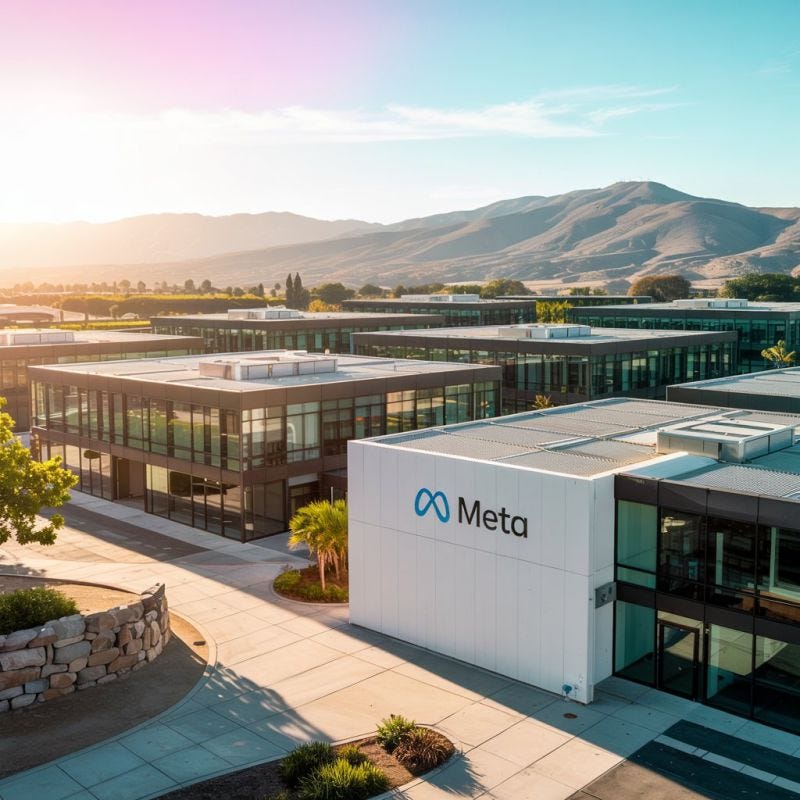$70B for AI: Meta’s Q2 Results Reveal the Scale of Its Infrastructure Ambition
Meta’s record quarter highlights its pivot into AI-first infrastructure while regional revenue trends show where demand is scaling fastest
Welcome to Global Data Center Hub. Join investors, operators, and innovators reading to stay ahead of the latest trends in the data center sector in developed and emerging markets globally.
Meta’s second quarter of 2025 underscored a pivotal shift.
While its advertising engine continues to compound cash at scale, the company is now deploying that capital into one of the largest AI infrastructure buildouts in history.
The headline is not just $47.5B in revenue (+22% YoY) or $18.3B in net income (+36%), but a CapEx commitment of $66–72B for 2025.
That figure (up sharply from prior years) signals a deliberate pivot from pure ad-tech dominance to infrastructure operator.
By funding GPU clusters, custom silicon, and next-gen data centers with ad-driven cash flow, Meta is positioning itself alongside Microsoft and Amazon in the race to anchor global AI infrastructure.
The question now is execution: can $70B in spend deliver durable returns without eroding margin strength?
Breakdown of Earnings & Infrastructure Strategy
Advertising Resilience: Ad revenue reached $46.6B (+21% YoY), with impressions up 11% and average price per ad up 9%. AI-driven ad tools are already producing tangible results, such as higher conversion rates on Reels, proving early ROI on infra investments.
Profitability: Net income of $18.3B and EPS of $7.14 (vs. $5.16 last year) reflect both top-line growth and efficiency gains. Operating margin expanded to 43% from 38%, aided by infrastructure efficiencies and lower legal costs.
Reality Labs: $370M in revenue but a $4.5B operating loss. Smart glasses showed promise, but Quest hardware lagged. While the losses remain large, cost controls prevented further widening.
CapEx Commitment: $17B in Q2 alone, trending to $70B for the full year. The bulk of spend is dedicated to GPUs, liquid-cooled data centers, and proprietary AI chips to power Meta’s Llama models and Meta AI deployments.
Capital Strategy: CFO Susan Li confirmed that Meta is considering external financing partnerships for data centers—an important signal that management wants to balance ambition with balance-sheet discipline.
Regional Growth Signals
Meta’s results show broad-based demand growth across geographies:
Europe & Rest of World: +24% YoY
US & Canada: +21% YoY
Asia-Pacific: +19% YoY
While Meta did not disclose new infrastructure projects outside of the U.S. and Europe, these regional trends highlight where user engagement and ad monetization are strongest.
For investors, the gap between revenue globalization and infrastructure localization is notable: APAC and Rest of World are scaling faster in revenue terms, but the infra build remains heavily developed-market centric.
Forecast & Strategic Close
Meta’s Q2 was more than an earnings beat, it was a capital allocation signal.
The company is committing $70B this year to AI data centers, compute, and talent, funded by one of the most profitable advertising engines in history.
That dual-engine model (compounder today, infrastructure operator tomorrow) defines Meta’s strategic trajectory.
For investors and operators, three signals stand out:
Scale: A $70B CapEx program puts Meta in the same league as Microsoft and Amazon as a global AI infrastructure buyer.
Margins vs. Spend: Expanding margins in Q2 prove that Meta can invest aggressively without immediate dilution—but sustaining this will be the real test.
Geographic Catch-Up: With revenue growth strongest in APAC (+19%) and Rest of World (+24%), infrastructure localization will need to follow if Meta wants to stay competitive in sovereign cloud and AI-ready markets.
Strategic Takeaway: Meta is no longer just monetizing 3.5B users, it is building the backbone for global AI.
The $70B commitment makes clear that Meta has chosen to compete not just as a platform, but as an infrastructure heavyweight.
For investors, the bet is simple: will today’s ad cash flows translate into tomorrow’s AI moat?

